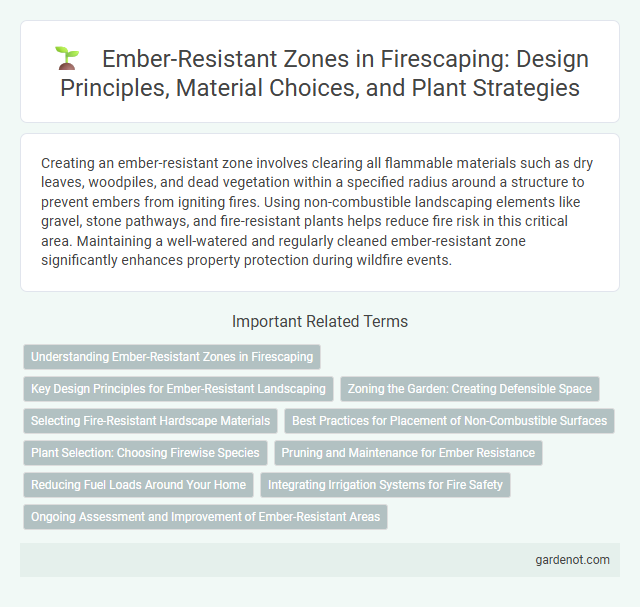Creating an ember-resistant zone involves clearing all flammable materials such as dry leaves, woodpiles, and dead vegetation within a specified radius around a structure to prevent embers from igniting fires. Using non-combustible landscaping elements like gravel, stone pathways, and fire-resistant plants helps reduce fire risk in this critical area. Maintaining a well-watered and regularly cleaned ember-resistant zone significantly enhances property protection during wildfire events.
Understanding Ember-Resistant Zones in Firescaping
Ember-resistant zones are critical areas surrounding a property designed to minimize the risk of ignition from airborne embers during wildfires. These zones typically extend 5 to 30 feet from a structure and involve using non-combustible materials, strategic vegetation placement, and maintaining clear, fuel-free spaces. Understanding and implementing ember-resistant zones significantly reduces the likelihood of embers igniting surrounding landscaping or the building itself, enhancing overall wildfire resilience.
Key Design Principles for Ember-Resistant Landscaping
Key design principles for ember-resistant landscaping include selecting non-combustible or fire-resistant plants with high moisture content, maintaining proper plant spacing to reduce fuel continuity, and incorporating hardscape elements such as stone pathways and gravel beds to interrupt fire spread. Emphasis on creating defensible space by regularly clearing dead vegetation and debris helps minimize ember accumulation near structures. Integrating these strategies enhances fire resilience by reducing ignition potential from embers during wildfires.
Zoning the Garden: Creating Defensible Space
Creating an ember-resistant zone involves zoning the garden to establish defensible space that reduces wildfire risks. Strategic placement of non-flammable plants and hardscape features within 30 feet of structures minimizes the presence of combustible materials. Regular maintenance, such as pruning and removing dead vegetation, enhances the garden's defense against ember attacks during fires.
Selecting Fire-Resistant Hardscape Materials
Selecting fire-resistant hardscape materials involves choosing non-combustible options such as concrete, stone, brick, and pavers made from fired clay or concrete. These materials withstand high temperatures, preventing ember ignition and reducing fire spread within the ember-resistant zone. Incorporating metal edging and fireproof gravel further enhances the landscape's ability to resist embers and protect structures.
Best Practices for Placement of Non-Combustible Surfaces
Establishing an ember-resistant zone requires strategically placing non-combustible surfaces such as stone, concrete, or metal within at least 5 feet of a structure's exterior to prevent ignition from flying embers. These surfaces should extend beneath eaves, decks, and adjacent to vents to minimize fire spread and protect vulnerable areas. Regular maintenance, including clearing debris and vegetation, enhances the effectiveness of non-combustible zones in reducing wildfire risks.
Plant Selection: Choosing Firewise Species
Selecting firewise species for an ember-resistant zone significantly reduces wildfire risk by using plants with low resin, sap, and oil content that resist ignition. Drought-tolerant, slow-growing shrubs like manzanita, ceanothus, and succulents create natural firebreaks and maintain soil moisture. Incorporating native plants adapted to the local climate enhances ecosystem resilience while minimizing fuel for embers.
Pruning and Maintenance for Ember Resistance
Regular pruning of shrubs and trees within the ember-resistant zone reduces dense foliage, minimizing potential fuel for fire embers. Removing dead branches and maintaining proper clearance between plants improves airflow, which lowers the risk of ember ignition. Consistent maintenance, including clearing leaf litter and debris, strengthens the ember-resistant barrier critical for effective firescaping.
Reducing Fuel Loads Around Your Home
Creating an ember-resistant zone requires strategically reducing fuel loads within 30 feet of your home by clearing dry leaves, dead vegetation, and flammable debris to minimize ignition risk. Maintaining well-watered, fire-resistant plants in this area decreases the chances of embers igniting fires near your structure. Regularly pruning trees and shrubs prevents overgrown branches from coming into contact with your home, further enhancing ember protection.
Integrating Irrigation Systems for Fire Safety
Integrating irrigation systems within the ember-resistant zone significantly reduces fire hazards by maintaining consistent moisture levels in vegetation and landscaped areas. Automated drip irrigation and smart controllers optimize water delivery, minimizing dry fuel buildup that can ignite from airborne embers. This proactive approach enhances fire safety by strengthening plant resilience and creating a defensible space against wildfires.
Ongoing Assessment and Improvement of Ember-Resistant Areas
Regular inspection and maintenance of ember-resistant zones are crucial to identify vulnerabilities such as gaps in vegetation or combustible debris buildup. Implementing adaptive strategies based on fire behavior data enhances the effectiveness of these zones in preventing ember intrusion. Continuous improvement through advanced materials and landscaping techniques supports long-term resilience against wildfire embers.
Ember-resistant zone Infographic

 gardenot.com
gardenot.com